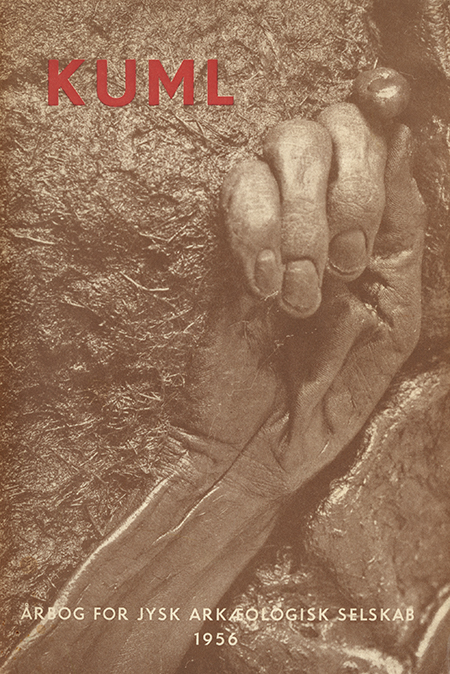Fra jyllands ældste jernalder
DOI:
https://doi.org/10.7146/kuml.v6i6.97288Nøgleord:
Pre-roman Iron Age, cemetary, førromersk, gravplads, Nim, first period, første periode, urn-grave, urnebrandgrube, cremation, brandgravResumé
A Pre-Roman Iron Age Cemetery at Nim in East ]utland
In 1953, in the course of digging gravel in a little hill near the village of Nim, about 12 kms. northwest of Horsens in East Jutland, six graves from the earliest Iron Age were discovered. Five of them were taken up by the workmen, the sixth (Grave IV) being excavated by members of the Jutland Archeological Society. It is, however, certain that the objects discovered, and described below, do in fact belong to the graves with which they are here listed.
The graves lay in a group near the summit of the hill, at a spacing of about 7 metres. This suggests that there were originally low barrows or cairns over each grave, but that these have been removed in the course of cultivation.
Grave I. The pottery vessel in Fig. 1 contained burnt bones, together with two iron pins and bronze ornaments (Fig. 3). There were in addition the remains of one or more bronze armlets, and a macehead of sandstone, of Stone Age type.
Grave II must have been a cremation patch containing sherds of the vessel shown in Fig. 2.
Grave III. A pottery vessel with burnt bones.
Grave IV. An urn-grave surrounded by blackened earth ("Urnebrandgrube"). In the urn lay a thin bronze ring, two iron pins, a massive belt-ring of bronze and a bronze clasp with double spiral (Fig. 5). The large break in the neck of the vessel must have been in existence at the time of burial, as otherwise the large ring could not have been introduced into the vessel.
Grave V. A pottery vessel contained unidentifiable fragments of iron, part of a ring with lug and a spiral clasp, together with fragments of armlet, all of bronze, (Fig. 6), and burnt bones.
Grave VI contained sherds of a pottery vessel.
All six graves from Nim belong to the first period of the Pre-Roman Iron Age (ca. 500-- 300 BC). The objects found are typical for Central Jutland and, despite their unspectacular character, form the richest cemetery yet found in the area. The discovery gives us certain pointers to the local culture-grouping in the earliest Iron Age in Jutland. The Pre-Roman Iron Age in Denmark is now divided into three periods 5); Period I corresponds to Jastorf a and b in Holstein and Hanover, Period II to Jastorf c and Ripdorf, and Period III to Early and Late Seedorf. In Period I a local group can be distinguished in South Jutland and Schleswig (Fig. 7), characterized by the large urn-fields (Aarre, Uldal, etc.). Here it is possible to recognise an early and a late phase 10), the first being characterized by rolled-headed pins 11) and large belt-rings with lugs (as in Fig. 6 c), the second showing in contrast ring-headed pins 12) and triangular belt-hooks of iron.
To the north of the local South Jutland group another group, contemporaneous and equally distinct, is found, the Central Jutland (Fig. 7). It is characterized by: 1. small cemeteries or single cremation graves; 2. cremation patches and "Urnenbrandgruben" are common (whereas almost unknown in the South Jutland group); 3. particular artifacts of metal, including small rings with lugs, like Fig. 3 d, and spiral clasps (Figs. 5 and 8; for distribution cf. Fig. 10); 4. peat-bog deposits, large and small, containing bronze rings 24) (Smederup near Odder containing over 350 rings, Falling Bog about 270 lugged rings, etc.); 5. coarser pottery; 6. artifact types which in the South Jutland group are confined to Period I a apparently persist in Central Jutland throughout the whole of Period I. Thus Nim appears to belong, on a basis of the pottery to late Period I, corresponding to I b further south.
To the north of the Central Jutland group there appears to be a third local group, but its components are not yet sufficiently characteristic to permit of closer description. One special type may, however, be mentioned, a plate-clasp (Fig. 9; for distribution cf. Fig. 10).
The three local groups within Period I of the Pre-Roman Iron Age in Jutland appear to have developed most clearly late in the period. They are therefore parallel to the Jastorf b group in Holstein. They appear to develop in all cases out of the much more homogeneous Period VI of the Bronze Age. Remarkably enough, the Jutland local groups in Period I appear to correspond geographically to important local groups in the Roman Iron Age 41). It should therefore be home in mind that these later local groups may well have traditions running far back into the Pre-Roman Iron Age.
C. J. Becker
Downloads
Publiceret
Citation/Eksport
Nummer
Sektion
Licens
Fra og med årgang 2022 er artikler udgivet i Kuml med en licens fra Creative Commons (CC BY-NC-SA 4.0).
Alle tidligere årgange af tidsskriftet er ikke udgivet med en licens fra Creative Commons.


